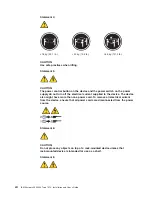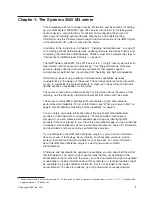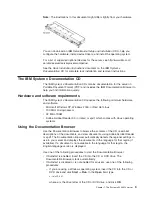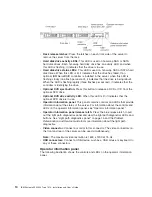
What your server offers
The server uses the following features and technologies:
v
Features on Demand
If a Features on Demand feature is integrated in the server or in an optional
device that is installed in the server, you can purchase an activation key to
activate the feature. For information about Features on Demand, see
http://www.ibm.com/systems/x/fod/.
v
Integrated Management Module II
The integrated management module II (IMM2) is the second generation of the
IMM. The IMM2 is the common management controller for IBM System x
hardware. The IMM2 consolidates multiple management functions in a single chip
on the server system board.
Some of the features that are unique to the IMM2 are enhanced performance,
expanded compatibility with blade servers, higher-resolution remote video,
expanded security options, and Feature on Demand enablement for hardware
and firmware options.
For additional information, see “Using the integrated management module II” on
page 115.
v
UEFI-compliant server firmware
IBM System x Server Firmware (server firmware) offers several features,
including Unified Extensible Firmware Interface (UEFI) 2.1 compliance; Active
Energy Manager technology; enhanced reliability, availability, and serviceability
(RAS) capabilities; and basic input/output system (BIOS) compatibility support.
UEFI replaces the BIOS and defines a standard interface between the operating
system, platform firmware, and external devices. UEFI-compliant System x
servers are capable of booting UEFI-compliant operating systems, BIOS-based
operating systems, and BIOS-based adapters as well as UEFI-compliant
adapters.
Note:
The server does not support DOS (Disk Operating System).
v
IBM Dynamic System Analysis Preboot diagnostics programs
The Dynamic System Analysis (DSA) Preboot diagnostics programs are stored
on the integrated USB memory. It collects and analyzes system information to aid
in diagnosing server problems. The diagnostic programs collect the following
information about the server:
– System configuration
– Network interfaces and settings
– Installed hardware
– Light path diagnostics status
– Service processor status and configuration
– Vital product data, firmware, and UEFI (formerly BIOS) configuration
– Hard disk drive health
– RAID controller configuration
– Event logs for ServeRAID controllers and service processors
The diagnostic programs create a merged log that includes events from all
collected logs. The information is collected into a file that you can send to IBM
service and support. Additionally, you can view the information locally through a
generated text report file. You can also copy the log to a removable media and
view the log from a web browser.
8
IBM System x3550 M4 Type 7914: Installation and User’s Guide
Summary of Contents for Redboks System x3550 M4
Page 1: ...IBM System x3550 M4 Type 7914 Installation and User s Guide...
Page 2: ......
Page 3: ...IBM System x3550 M4 Type 7914 Installation and User s Guide...
Page 8: ...vi IBM System x3550 M4 Type 7914 Installation and User s Guide...
Page 46: ...30 IBM System x3550 M4 Type 7914 Installation and User s Guide...
Page 58: ...42 IBM System x3550 M4 Type 7914 Installation and User s Guide...
Page 88: ...72 IBM System x3550 M4 Type 7914 Installation and User s Guide...
Page 138: ...122 IBM System x3550 M4 Type 7914 Installation and User s Guide...
Page 142: ...126 IBM System x3550 M4 Type 7914 Installation and User s Guide...
Page 150: ...134 IBM System x3550 M4 Type 7914 Installation and User s Guide...
Page 156: ...140 IBM System x3550 M4 Type 7914 Installation and User s Guide...
Page 157: ......
Page 158: ...Part Number 00V9702 Printed in USA 1P P N 00V9702...
















































